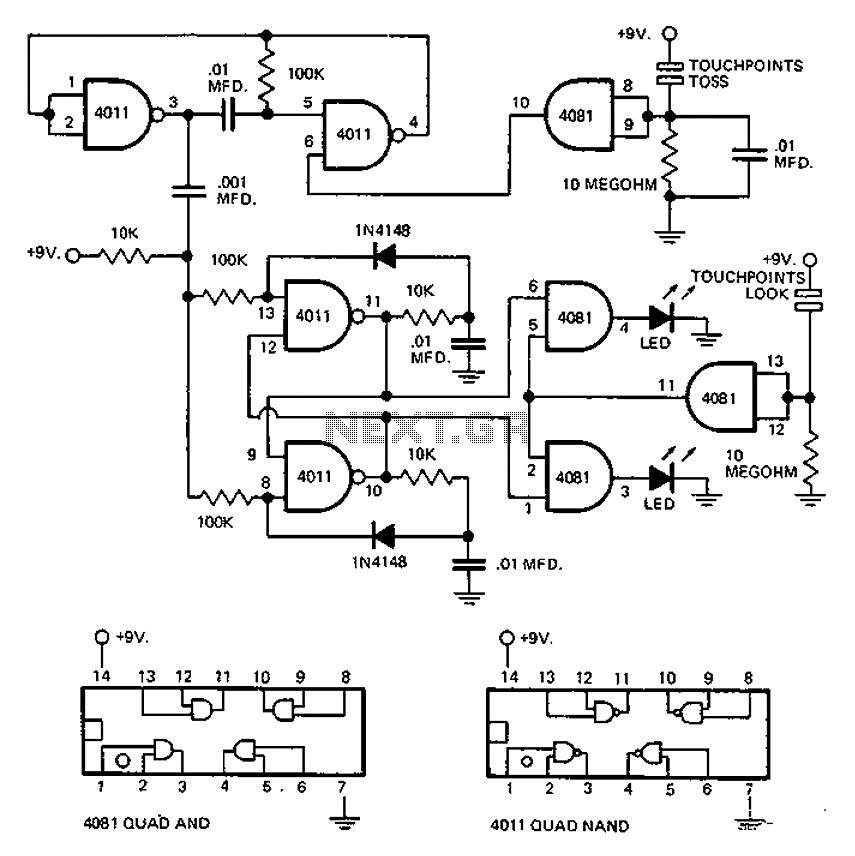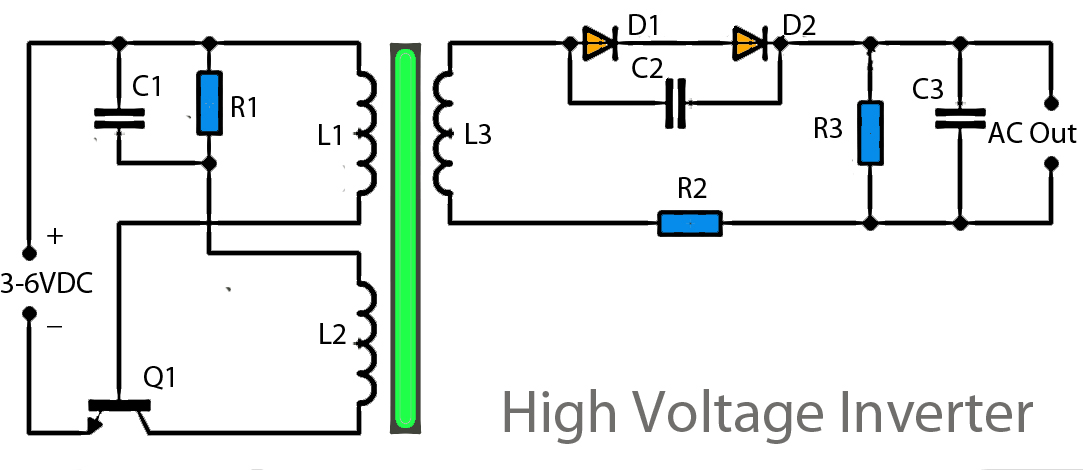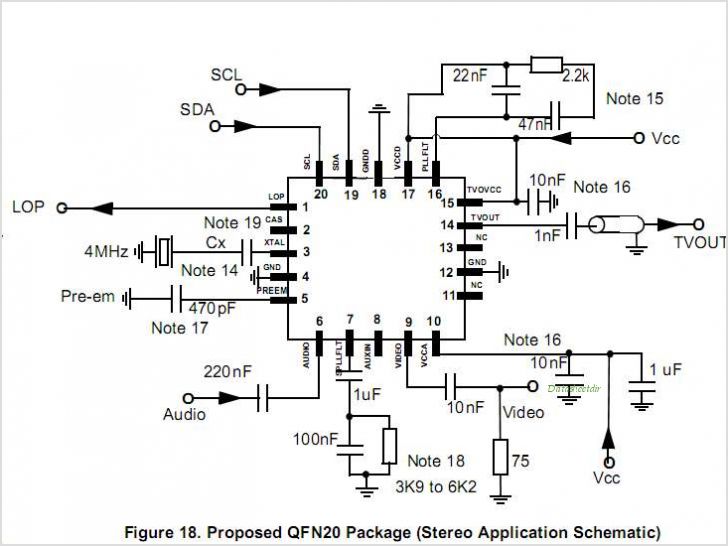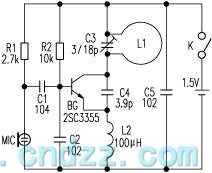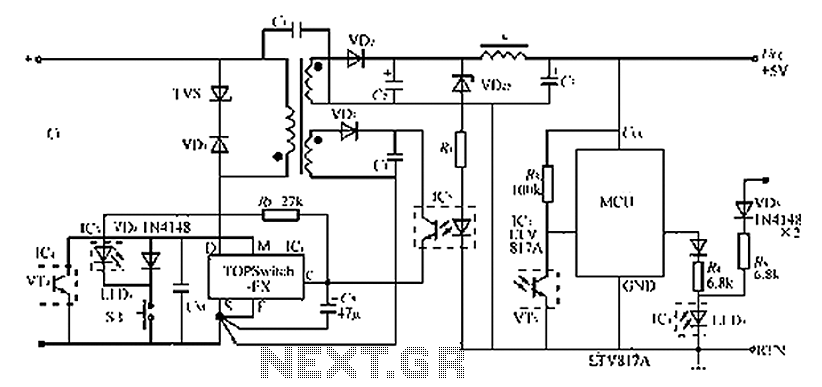
Audio Speaker Crossover Circuit
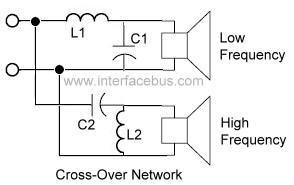
An audio crossover network is utilized within a speaker to separate or filter audio signals of varying frequencies to different speakers inside a speaker cabinet designed for those frequencies. This specific crossover network employs two passive components for each filter. The low-pass filter consists of inductor L1 and capacitor C1, intended to transmit low frequencies to a bass speaker or woofer. The series inductor L1 tends to impede high frequencies (the reactance XL increases) while allowing low frequencies to pass through. Concurrently, the impedance of the parallel capacitor C1 is greater at lower frequencies, enabling it to transmit all energy to the speaker at low frequencies. However, as frequency increases, more energy is dissipated across the inductor, resulting in less energy reaching the speaker. The high-pass filter comprises inductor L2 and capacitor C2, designed to allow high frequencies to reach a tweeter. The series capacitor C2 blocks or reduces low frequencies from reaching the speaker, while inductor L2 permits high frequencies to pass. Simplifying the circuit could involve leaving just the capacitor in the circuit with the speaker, forming a voltage divider. Typical values for the inductors are around 1 mH, while the capacitors are about 16 µF. Nevertheless, various values within these ranges can be employed depending on the desired crossover speed and the type of speakers used. It is important to note that the acoustics of a speaker are influenced by the room it is placed in and the enclosure or cabinet utilized. Among the speakers referenced are two 4-way, 6-speaker KL-777A models from Kenwood, which cover the audio frequency range of 25 Hz to 22,000 Hz. The KL-777A features a tone selector that adjusts the sound to soft, normal, or clear, as indicated on the knob. The crossover frequencies are specified at 700 Hz, 5000 Hz, and 10,000 Hz (bass, midrange, high range), with a crossover network indicating a 12 dB/octave slope. Additionally, a set of KL555A speakers has crossover frequencies noted at 800 Hz and 5000 Hz, also equipped with a tone selector. It is essential to mention that some home entertainment speakers, which may consist of one or two identical speakers, might not incorporate a crossover network at all. Due to the subjective nature of preferences, specific values are not indicated in the circuit schematic. The documentation includes schematic diagrams for both passive and active circuits, including instances where a passive circuit is combined with an active circuit, such as an operational amplifier.
The audio crossover network is a critical component in multi-driver speaker systems, ensuring that each speaker driver operates within its optimal frequency range. The low-pass filter is designed to direct low-frequency signals to the woofer, which is adept at producing bass sounds. The inductor L1, acting as a low-pass filter, increases its reactance with frequency, effectively blocking high-frequency signals and allowing only the desired low frequencies to pass through to the woofer. Capacitor C1, connected in parallel, complements this by presenting higher impedance at lower frequencies, ensuring maximum energy transfer to the woofer.
Conversely, the high-pass filter is configured to facilitate high-frequency signals to the tweeter. In this configuration, capacitor C2 blocks low-frequency signals, while inductor L2 allows high-frequency signals to be transmitted to the tweeter. This arrangement is essential for achieving clarity and detail in the high-frequency range, which is critical for reproducing vocals and high-pitched instruments accurately.
The crossover frequencies are carefully chosen based on the characteristics of the drivers used, ensuring a smooth transition between frequency ranges. The specified crossover points of 700 Hz, 5000 Hz, and 10,000 Hz for the KL-777A speakers provide a balanced sound profile across bass, midrange, and treble frequencies. The 12 dB/octave slope indicates a gradual roll-off, which helps to minimize phase issues and provide a more coherent soundstage.
In designing a crossover network, the choice of component values is essential. Inductors and capacitors can be selected from a range of standard values, with 1 mH for inductors and 16 µF for capacitors being common choices. The specific values can be adjusted based on the desired performance characteristics and the acoustic environment.
Overall, the implementation of a crossover network is fundamental in multi-way speaker designs, ensuring that each driver operates efficiently within its designated frequency range, thus enhancing the overall sound quality and listening experience.An audio cross-over network is used inside a speaker to separate or filter audio signals of different frequencies to different speakers within a speaker cabinet designed to handle those frequencies. This particular crossover network uses two passive components for each filter. The low-pass filter is comprised of inductor L1 and capacitor C1, and i s designed to pass low frequencies to a bass speaker or woofer. The series inductor [L1] tends to block high frequencies [XL increases], while passing low frequencies. At the same time the impedance of the parallel capacitor C1 is higher at lower frequencies. So at low frequencies the capacitor passes all the energy to the speaker, but as the frequency grows more energy is lost over the inductor, passing less energy to the speaker.
The high-pass filter is comprised of inductor L2 and capacitor C2, and is designed to pass high frequencies to a tweeter. The series capacitor C2 blocks or attenuates low frequencies from reaching the speaker, while the inductor L2 passes high frequencies to the speaker.
Reducing the circuit could just leave the capacitor in circuit with the speaker forming a voltage divider. Common values to use include 1mH for the inductors and 16uF for the capacitors. However almost any common value around those ranges will do depending on how fast, or slow, you want the crossover to take place between the speakers and the types of speaker used.
Remember much of how a speaker sounds depends on the room it`s placed in and of course the enclosure or cabinet that`s used. Among the speakers the editor uses include two 4-way, 6-speaker, KL-777A speakers from Kenwood covering the 25 - 22, 000Hz audio frequency range.
The KL777A has a tone selector which changes the sound from soft, normal, or clear [as stated on the knob]. The crossover frequencies are stated at 700Hz, 5000Hz and 10000Hz [Base, Midrange, High range]. The crossover network also states a 12dB / octive change. A set of KL555A have the crossover frequencies stated at 800Hz, 5000Hz, also with a tone selector. Of course some home entertainment speakers, having only one speaker or two of the same type my not have a cross-over network at all.
In any event because the preference is almost user defined, no values are used in the circuit schematic above. The pages provide schematic diagrams for both passive and active circuits, and in some cases a passive circuit that is also used with an active circuit [operational amplifier].
🔗 External reference
The audio crossover network is a critical component in multi-driver speaker systems, ensuring that each speaker driver operates within its optimal frequency range. The low-pass filter is designed to direct low-frequency signals to the woofer, which is adept at producing bass sounds. The inductor L1, acting as a low-pass filter, increases its reactance with frequency, effectively blocking high-frequency signals and allowing only the desired low frequencies to pass through to the woofer. Capacitor C1, connected in parallel, complements this by presenting higher impedance at lower frequencies, ensuring maximum energy transfer to the woofer.
Conversely, the high-pass filter is configured to facilitate high-frequency signals to the tweeter. In this configuration, capacitor C2 blocks low-frequency signals, while inductor L2 allows high-frequency signals to be transmitted to the tweeter. This arrangement is essential for achieving clarity and detail in the high-frequency range, which is critical for reproducing vocals and high-pitched instruments accurately.
The crossover frequencies are carefully chosen based on the characteristics of the drivers used, ensuring a smooth transition between frequency ranges. The specified crossover points of 700 Hz, 5000 Hz, and 10,000 Hz for the KL-777A speakers provide a balanced sound profile across bass, midrange, and treble frequencies. The 12 dB/octave slope indicates a gradual roll-off, which helps to minimize phase issues and provide a more coherent soundstage.
In designing a crossover network, the choice of component values is essential. Inductors and capacitors can be selected from a range of standard values, with 1 mH for inductors and 16 µF for capacitors being common choices. The specific values can be adjusted based on the desired performance characteristics and the acoustic environment.
Overall, the implementation of a crossover network is fundamental in multi-way speaker designs, ensuring that each driver operates efficiently within its designated frequency range, thus enhancing the overall sound quality and listening experience.An audio cross-over network is used inside a speaker to separate or filter audio signals of different frequencies to different speakers within a speaker cabinet designed to handle those frequencies. This particular crossover network uses two passive components for each filter. The low-pass filter is comprised of inductor L1 and capacitor C1, and i s designed to pass low frequencies to a bass speaker or woofer. The series inductor [L1] tends to block high frequencies [XL increases], while passing low frequencies. At the same time the impedance of the parallel capacitor C1 is higher at lower frequencies. So at low frequencies the capacitor passes all the energy to the speaker, but as the frequency grows more energy is lost over the inductor, passing less energy to the speaker.
The high-pass filter is comprised of inductor L2 and capacitor C2, and is designed to pass high frequencies to a tweeter. The series capacitor C2 blocks or attenuates low frequencies from reaching the speaker, while the inductor L2 passes high frequencies to the speaker.
Reducing the circuit could just leave the capacitor in circuit with the speaker forming a voltage divider. Common values to use include 1mH for the inductors and 16uF for the capacitors. However almost any common value around those ranges will do depending on how fast, or slow, you want the crossover to take place between the speakers and the types of speaker used.
Remember much of how a speaker sounds depends on the room it`s placed in and of course the enclosure or cabinet that`s used. Among the speakers the editor uses include two 4-way, 6-speaker, KL-777A speakers from Kenwood covering the 25 - 22, 000Hz audio frequency range.
The KL777A has a tone selector which changes the sound from soft, normal, or clear [as stated on the knob]. The crossover frequencies are stated at 700Hz, 5000Hz and 10000Hz [Base, Midrange, High range]. The crossover network also states a 12dB / octive change. A set of KL555A have the crossover frequencies stated at 800Hz, 5000Hz, also with a tone selector. Of course some home entertainment speakers, having only one speaker or two of the same type my not have a cross-over network at all.
In any event because the preference is almost user defined, no values are used in the circuit schematic above. The pages provide schematic diagrams for both passive and active circuits, and in some cases a passive circuit that is also used with an active circuit [operational amplifier].
🔗 External reference
